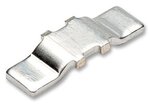snipex
Junior Member level 3

Hi
I'm currently working on a BLDC inverter and I need better cooling of SMD MOS-FETs.
I'm looking into aluminium PCBs and I cant find a guideline or a calculator that shows me how wide the traces must be for a given current.
PCB will be mounted on a heatsink.
I need 100A peak for 1-2s and 30A constant current.
Side question: Has anybody worked with aluminium PCB that then transfers current to a FR4 board? I'm looking into SMD high current jumpers but I can't find any.
They have to be 20mm in length.
I'm currently working on a BLDC inverter and I need better cooling of SMD MOS-FETs.
I'm looking into aluminium PCBs and I cant find a guideline or a calculator that shows me how wide the traces must be for a given current.
PCB will be mounted on a heatsink.
I need 100A peak for 1-2s and 30A constant current.
Side question: Has anybody worked with aluminium PCB that then transfers current to a FR4 board? I'm looking into SMD high current jumpers but I can't find any.
They have to be 20mm in length.




